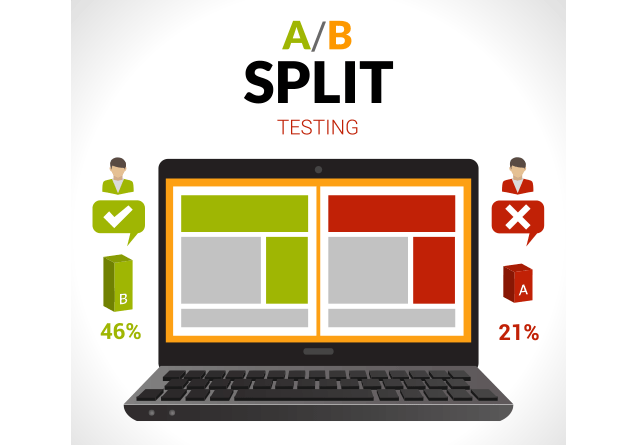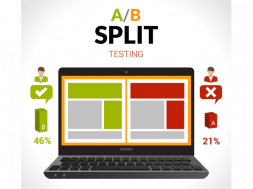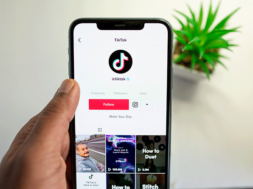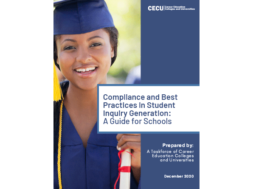
By Gregg Meiklejohn, Co-Founder, Enrollment Resources and Michael Schulte, VP of Strategic Initiatives, Enrollment Resources
Recently, we gave a talk at a marketing conference. We began by asking a question to the audience:
Imagine you are running a marketing department (most in the room were) and you’re only allowed to be excellent at one skill set – and mediocre at the rest – to help you meet your objectives. Which of the following would you choose, and why?
- Extraordinary design skills
- Tremendous copywriting or persuasive communication skills
- Permission to split test ideas without fear of failure
- Excellent brand-building social media campaigns
- Effective media buying and the ability to find pools of interest
The audience debated amongst themselves before defending their choices. Some backed design as a crucial element for grabbing attention, while others said copywriting was critical in persuading a prospect to take action. We heard a compelling argument for media buying about how filling a trout pond with more trout gives you a better shot at catching something. A few people threw their hats in for social media.
The lone voice of Andrew Dixon advocated for split testing. He said it was far and away the most important skill to own and hone.
His logic was simple: mediocre skill sets in design, writing, content distribution, and media buying can be made world-class over time through trial and error, otherwise known as split or A/B testing.
Andrew showed that he understood the core driver for success when it came to marketing and sales.
In our opinion, for this reason alone, we are of the firm belief that Andrew will never, ever get fired.
Job security through a culture of testing
Owning a senior position at your school comes with as much stress and danger as it does benefit. Your boss or board is pushing for performance. Less-secure peers are either jealous of your success or are deflecting blame for their shortcomings. Campus managers and DoA’s are begging for support. And of course, there’s a constant stream of vendors trying to manipulate you into buying their stuff. The pressure is constant, intense, and exhausting. There may be times you feel like all eyes are upon you, waiting for you to slip up.
Unless you own a school, let’s be honest – securing your career path is super important. You need to create results and deliver ROI and survive daily challenges while avoiding toxic people. You need to support your team with effective branding, lead gen, and lead conversion. On top of everything else, you need to organize vendors in such a way that they serve you and not the other way around.
The solution to alleviating all of these pressures while looking like a rock star is to split test as much as possible.
The compelling argument for split testing everything
Testing is the only way to know whether ideas are good, bad, or inconsequential. At Enrollment Resources, we believe split testing is the only tactic a school can use to increase revenues and consistently protect operating budgets. By extension, the Chief Testing Professional (CTP) – the person who develops a culture of testing – cements herself as one of the most valuable members of her organization.
Split testing 101
Split testing was developed over 100 years ago in the direct response marketing industry. The bible for split testing is a book written by Claude Hopkins in the 1920s called “Scientific Advertising.” This is the only marketing book you’ll ever need to read.
Today, many companies such as Toyota and Apple actively use what are called lean management techniques to improve revenue and efficiencies through tiny tests incrementally. In higher education, Enrollment Resources is leading the charge in having schools use this subtle technique to increase enrollment while trimming budgets along the way.
In split or A/B testing, a different element is tested against a benchmark or ‘control.’
The goal is to determine which one produces a better result – if the variable beats the control.
Split testing is a move forward process that optimizes revenues and profits, in turn creating conversion rate breakthroughs. It’s a game changer for schools. There are over 200 potential engagement points within your enrollment management process that can be tested and improved through trial and error: your website, phone messaging, sales letters, admission procedures, and student retention communication, to name a few.
Anyone can deploy split tests, it doesn’t require a significant investment of time or money, and your school doesn’t have to overhaul its current practices. What it does require, however, is that you adopt a culture of testing: embracing failure and practicing patience.
Culture of testing
Process improvement requires a certain business culture to succeed. By their very nature, competitive cultures tend to punish people who initiate ideas that don’t result in immediate positive returns. In a competitive culture, if your idea “loses,” then you are a “loser.” Within the wrong operating culture, a so-called “loser” risks consequence ranging from losing face to tanking a career – not cool.
Schools that focus on process improvement test ideas multiple times with the encouragement of school leaders. For every 10 test ideas that “fail,” one will win. Typically, a winning test creates positive impacts, with powerful and permanent improvements. That powerful idea is now your school ’s asset. That asset would not have existed in a culture that punishes failure. Test ideas, improve processes and create conversion rate breakthroughs: cause and effect.
The split testing process
Testing is a bit chaotic, so ideas that are up for testing need to be tightly managed. The method or track must be agreed upon in advance, so test results are accurate. Here’s a high-level example:
- Make an observation and form a hypothesis on how to improve an established process.
- Create a short brief used to manage a test that is attacking an existing process.
- Run the test and record the findings, then draw a conclusion.
- Establish whether the test beat the previous control.
- If the test wins, it’s a now the new control or existing best practice.
- Replicate.
Split test everything … just do so one at a time
Everything can be tested: autoresponders, keywords, ads, images, guarantees, deadlines, navigation, font sizes, payment options, colors, you name it! However, only test one element at a time to keep results as accurate as possible.
Here are some ideas to get you started:
Admissions officers and their phone messages.
Imagine the phone messages your admissions officers leave are in fact radio ads, with an audience of one. If you accept this notion, you can then split test what was said. Typically, after six to seven ‘tests,’ a rep can get a 5-10 percent lift in the number of callbacks she receives. You might say to yourself 5 percent, big deal. But let’s run the math.
If a rep makes 30 outbound calls a day and we can, through testing phone message scripts, provide a 5 percent lift in callbacks, that represents an additional 360 meaningful conversations a year or 54 students a year for one admissions officer. The lift is probably north of $1 million in enrollment revenue. Not so bad.
Subject lines on sales letters.
If through testing, you can get 15 percent more people to open a sales letter and that increased interest holds through the admission process, enrollment will increase.
Testing testimonials in school reception areas.
Here is a cheap and easy test: Put on the wall of your reception area, 15 or so testimonial letters. The hope is you provide additional comfort to the prospective student that they are doing the right thing. The 15-20 minutes that prospective students spend at the beginning of a visit asking themselves, “Why the heck am I here?” are largely dissolved. The officer then wins an additional 20 percent of quality time with the prospective student. We hope this, in turn, will generate an extra two enrolled students a month per officer. Stated differently, that is half a million in additional enrollment revenue per officer, per annum.
Test reminder times for show rates.
Schools remind people in several different ways to help ensure they show up. Try different ways, whether it be email, phone message or text and times – a day before, a week before, etc. Reminding the prospective student by text 1-2 hours prior to the meeting is a positive result we have found through our testing.
Test email campaigns through Mailchimp.
Split test subject lines, content elements, and the day and time the email is sent. If you find through testing that prospective students open emails between 9 and 11 p.m., time your email campaigns to go out at 8 p.m., so the communication is at the top of one’s inbox. Perhaps the open rates will skyrocket, or perhaps not. But nothing bad will happen if you run this test.
Website photos.
Test how many website inquiries are generated when photos of relatable, ordinary people are tested against what agencies put in websites – ‘supermodels with gleaming teeth.’ I’ll bet you will find that website photos of relatable people (just like you and I) will generate more leads.
A recent test we completed generated an impressive lift of 28.5 percent in additional inquiries.
Will that test work for you? We don’t know if it will work for your school. But it will probably help. Maybe you add 100 leads a month due to this test, maybe you add 10. Either way, run the math, and you’ll find revenues will probably lift with little effort.
Test website headlines used on mobile devices.
We recently tested a landing page headline written in a conversational tone (like a heart-to-heart over coffee) to see if it would outperform the typical, corporate language-laden copy many schools use. The majority of traffic for this test was from smartphones, where the headline was the only messaging visible without scrolling. At the time of the publication of this article, our test was out-performing the control by 45.7 percent.
Your vendors and suppliers – promises or proof?
Ask vendors if they will guarantee their work. See what they say. Will they redo their work, or offer pilot projects and invoicing guarantees? If your vendors won’t give you a straight answer, they are essentially answering “no, we won’t guarantee anything, ever.” In our opinion, you are better off without them. Vendors who stand behind their work are golden.
Test ideas from other industries.
Test ideas that are inspired by outside industries. Rework them for higher education.
At Enrollment Resources, we live for trying to beat the control. We’re proud that our culture of testing makes it safe for our staff to share ideas. The ability for them to take risks without putting their career on the line creates energy and enthusiasm. You can do this too. It will ultimately generate for you a strategic advantage over competitors.
It’s worth repeating: in our opinion here at Enrollment Resources, conversion rate optimization is the only tactic a school can use to consistently increase revenues without having to buy advertising or hire people. If leaders can embrace a culture of sharing within their school, those doing the testing will become more important than ever.
GREGG MEIKLEJOHN specializes in strategic marketing. He is an expert in branding businesses through online and traditional public relations tactics. Gregg developed the award-winning program Knowledge Communities, which has consistently given clients massive returns at pennies on the dollar (when compared to advertising). He is our company’s Scenario Planner, analyzing and calling industry trends before they emerge into public view. Gregg has over 20 years of marketing experience and frequently delivers workshops and teaching sessions via Webinar and at conferences in North America.
Contact Information: Gregg Meiklejohn // Co-Founder/CEO // Enrollment Resources Inc. // 250-391-9494 (PST) // Gregg@EnrollmentResources.com // www.EnrollmentResources.com
MICHAEL SCHULTE is a higher education marketing executive with over 10 years of experience in enrollment management, student recruitment, lead generation, admissions support solutions, and market research and strategy in highly competitive markets. He is adept at helping schools execute their vision, build a stronger brand and establish a bigger footprint in new territories through performance-based marketing strategies. He aids schools in communicating their value proposition in the most cost-effective way, enabling them to implement dependable low-risk solutions that appeal to all stakeholders.
Contact Information: Michael Schulte // VP of Strategic Initiatives // Enrollment Resources Inc.// 250-391-9494 (PST) // Michael@EnrollementResources.com // www.EnrollmentResources.com













Comment(1)